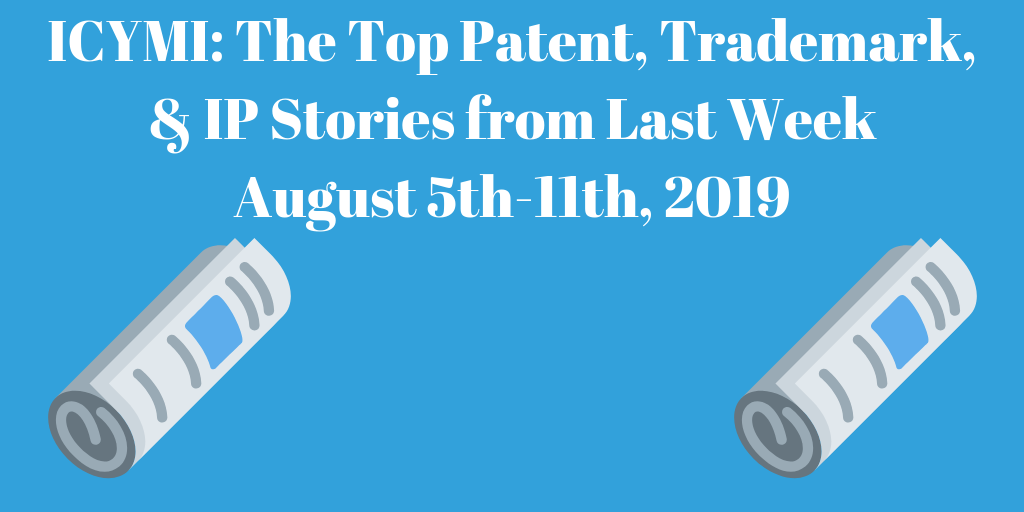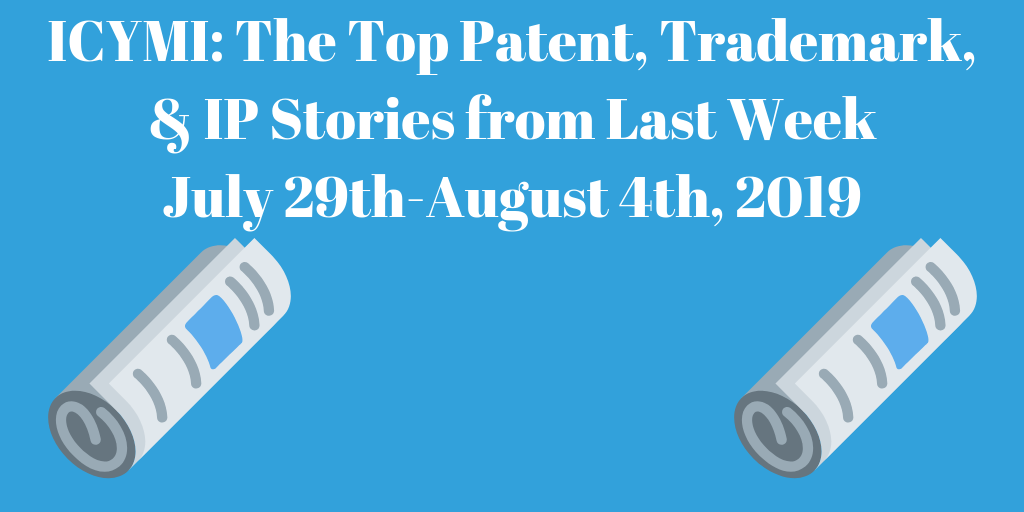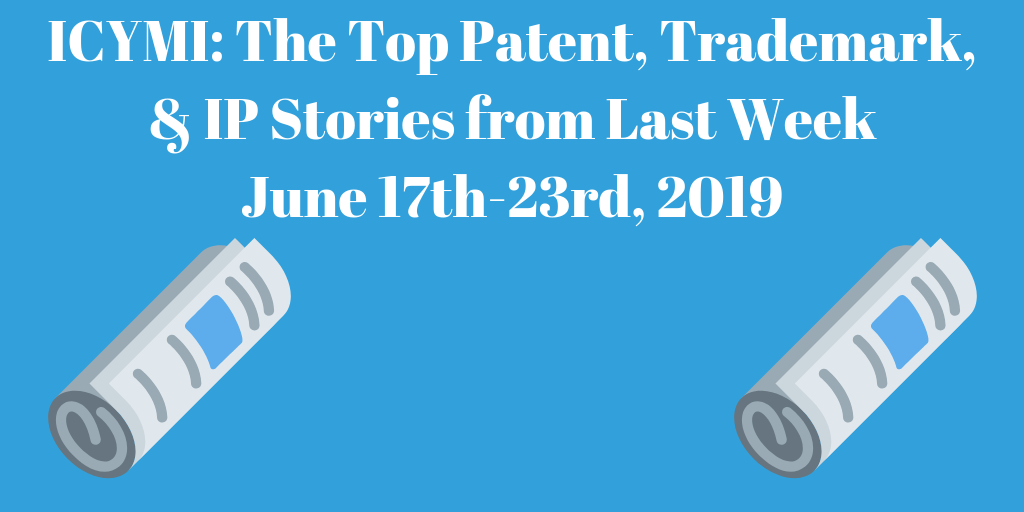Top Patent, Trademark, and IP Stories from Last Week (4/1-4/7/19)
Every week, we will be highlighting the top patent, copyright, trademark, intellectual property, etc. stories of the previous week in our “In Case You Missed It” segment. The list itself is in no particular order and includes a wide range of stories from the patent world that are informative, noteworthy, or just plain bizarre. The stories included encompass everything from Supreme Court cases to insights into growing industries. Please feel free to comment your thoughts on the stories or share an important one we missed!
1.) “Toyota Is Giving Automakers Free Access to Nearly 24,000 Hybrid Car-Related Patents”
Toyota has announced it will be offering rival automakers royalty-free access to approximately 24,000 electrification patents. The patents relate to hybrid electric and fuel cell technology. The move seeks to encourage competitors to “adopt the low-emissions and fuel-saving technology” and drive further innovation. As part of the offering, Toyota will also provide technical support to automakers who use their technologies for a fee.
The gesture is yet another example of a giant company making their patents available in order to encourage innovation. Last week we wrote about Microsoft who recently announced they would grant Azure users and startups access to nearly 10,000 software patents.
By offering their intellectual property to rivals, Toyota believes the gesture will prompt government and industry interest towards the development of electric vehicle technology. The company stated such a prospect will “further promote the widespread use of electrified vehicles, and in so doing, help governments, automakers, and society at large accomplish goals related to climate change.” The company stressed the importance of cooperation in combating climate change.
Here is a breakdown of patents provided:
- Fuel cell: 8,060
- System controls: 7,550
- Electric motors: 2,590
- Charger: 2,200
- Passenger car unit (PCU): 2,020
- Transaxle: 1,320
To read more about this story, click here (via TechCrunch, April 3rd, 2019).
2.) “Amazon Hot Air Balloon Prime Air Patent Describes Stealthy Delivery Drones”
Last week, Amazon was granted a patent for an “Unmanned Aerial Vehicle With Inflatable Membrane.” The patent covers what is essentially a delivery unmanned aerial vehicle (UAV) with an attached inflatable balloon(s) and balloon inflation system. The UAV will be capable of delivering packages from a package handling facility to the intended delivery location.
The balloon apparatus attached to the UAV will allow the device to ascend from the package facility, travel at a high altitude, and then descend to the intended location. The “inflatable membrane” aka balloon will be filled with gas via an on-board compressed gas chamber. This will allow motors to do less work and increase travel distance capability. The only real necessity for the motors would be for positioning purposes.

Because UAVs are known for being aggressively loud, Amazon claims the device’s ability to ascend and descend via the balloon apparatus will also help reduce noise by reducing motor work. Because most devices will be deployed in neighborhoods, such noise reduction will be of great benefit to homeowners.
In order to prevent propellers on the UAV from coming into contact with the inflatable membrane, the patent indicates the inclusion of a “retraction mechanism” to avoid such a collision. Another feature included would be a “stabilization mechanism.” This would allow the membrane to inflate at an appropriate distance from the propellers.
This is not Amazon’s first attempt at patenting package delivery mechanisms via drone. In 2017, the company patented a method for delivering packages via parachutes deployed from drones. Although it is hard to say whether any of Amazon’s drone ideas will become reality, such proposals demonstrate the evolution of package delivery. Will the postman be replaced by a drone? That is yet to be seen. To read more about this story, click here (via SlashGear, April 2nd, 2019).
3.) “The Federal Circuit Just ‘Swallowed All of Patent Law’ in ChargePoint v. SemaConnect”
In late March, the Federal Circuit decided on ChargePoint v. SemaConnect, a case brought by ChargePoint who claimed SemaConnect had infringed on their patents related to networked electric vehicle charging stations. SemaConnect subsequently filed a motion to dismiss and ChargePoint later appealed. The Federal Circuit upheld the decision, ruling that “communication over a network to interact with a device connected to the network” as described in one of ChargePoint’s patents is an abstract idea and cannot “supply an inventive concept that renders a claim.”
Claim 1 of ChargePoint’s “Network-controlled charging system for electric vehicles” patent reads an apparatus, comprising:
- “a control device to control application of charge transfer for an electric vehicle;
- a transceiver to communicate with a remote server via a data control unit that is connected to the remote server through a wide area network and receive communications from the remote server, wherein the received communications include communications as part of a demand response system; and
- a controller, coupled with the control device and the transceiver, to cause the control device to modify the application of charge transfer based on the communications received as part of the demand response system.”

In its opinion, the Court writes, “it is clear from the language of Claim 1 that the claim involves an abstract idea—namely, the abstract idea of communicating requests to a remote server and receiving communications from that server.” The court went on to state that Claim 1 is the abstract idea and the “broad claim language” of it would prevent the industry’s ability to utilize network charging stations.
Author Russell Slifer, electrical engineer and patent attorney, argues the ruling is “entirely incorrect and in effect overrules the new USPTO guidance.” Slifer iterates that the complexity of the machine described in Claim 1 is “anything but abstract” and “[does] not preempt all ways of charging a vehicle using a network.” There are switches, transceivers, controllers, etc. that all play a part in the charging of the vehicle.
In his concluding paragraph, Slifer brings up the Supreme Court’s decision on the infamous Alice Corp. vs. CLS Bank case. In that case, the Court ruled that an invention is “not rendered ineligible for patent simply because it involves an abstract concept.” He goes on to conclude that the Federal Circuit may have jeopardized this ruling by relying solely on the revised subject matter eligibility guidance and not the greater patent statutes. To read more about this story, click here (via IPWatchdog, April 2nd, 2019)
4.) “Auburn Files Trademark for ‘Draining Threes and Rolling Trees’ Amid Final Four Run”
After clinching its first Final Four appearance, Auburn University filed a trademark on the phrase “Draining Threes and Rolling Trees.” The phrase is a reference to the basketball team being one of the best 3-point shooters in the NCAA combined with a campus tradition of festooning massive on-campus oak trees with toilet paper (aka “rolling trees”). The filing is another example of how the NCAA and colleges alike will pounce on any phrase or slogan popularized by the March Madness tournament. To read more about this story, click here (via AL.com, April 6th, 2019).




